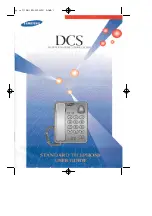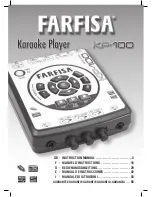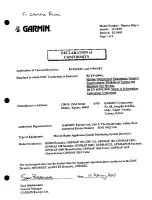
GB
19
18
GB
To obtain the best possible results from your mini-compact system,
you must clean the following elements regularly:
The outer casing
The compact disc player
The cassette players (heads, rollers and drive capstans)
Always unplug the system from the wall outlet:
Before cleaning it
If you are not going to be using it for a long time
Outer Casing
Clean the outer casing regularly using a soft cloth and a light detergent. Do not use
abrasive powders, liquids or aerosol cleaners. Never let any liquids get into the system.
Compact Disc Player
Before playing a compact disc, clean it with a special CD cleaning
agent. Do not use the same cleaning agents as for vinyl LP records.
Carefully wipe the disc from the centre outwards.
Regularly clean the player with a special cleaning disc (available from
your local dealer).
Tape Decks
Press STOP/EJECT(
) to open the cassette deck.
Use a cotton bud and a special cassette cleaning agent to clean the:
Head (1)
Rollers (2)
Drive capstans (3)
If you will not be using the remote control for a long time,
remove the batteries to prevent corrosion.
Although your system is very hard-wearing, it should not be
used in an excessively dusty environment or subjected to
shocks or extreme heat (close to heating appliances or in
direct sunlight, etc.).
If the unit emits an unpleasant odour when in use, unplug it
from the main supply and contact the after-sales service.
Handle your compact discs with care. Always hold them by the edges
to avoid leaving fingerprints on the shiny surface.
When you have finished playing a compact disc, always put it back in its case.
Do not fix paper or adhesive tape to the discs and do not write on the label.
Clean them with a special-purpose cloth.
Store your compact discs in a clean place, out of direct sunlight,
where they will not be exposed to high temperatures.
Always use compact discs marked.
Check that the tape in the cassette is sufficiently taught.
To prevent erasing a cassette that you wish to keep, remove the safety
tab on the upper edge of the cassette. To record a cassette, where the
tab has been broken, simply cover the opening with adhesive tape.
When you have finished playing a cassette, always put it back in its case.
Store your cassettes in a clean place, out of direct sunlight, where they
will not be exposed to high temperatures.
Avoid using 120-minute cassettes as they place unnecessary strain on
the tape mechanism.
It always takes a little time to become familiar with a new appliance. If you have
any of the problems listed below, try the solutions given. They may save you the
time and inconvenience of an unnecessary service call.
If the above guidelines do not allow you to solve the problem, take a note of:
The model and serial numbers, normally printed on the rear of the system
Your warranty details
A clear description of the problem
Then contact your local dealer or SAMSUNG after-sales service.
Cleaning Your Mini-Compact
System
Precautions When Using Audio
Cassettes
Before Contacting the After-Sales
Service
Precautions When Using Compact
Discs
1
1
2
2
COMPACT
DIGITAL AUDIO
Problem
The system does not work
There is no sound
The Timer does not work
The compact disc player does not
start playing
The tape does not start playing
The volume falls off
The cassette is not erased correctly
There is excessive wow and flutter
Reception is poor or no radio sta-
tions are received at all
G
E
N
E
R
A
L
C
D
R
A
D
I
O
C
A
S
S
E
T
T
E
S
Checks/Explanation
• The main lead is not correctly plugged into a
wall socket or the wall socket is not switched on.
• The remote control batteries need replacing or
the polarity has not been respected.
• The POWER button has not been pressed.
• The volume has been completely turned down.
• The correct function (TUNER, CD, AUX) has
not been selected.
• You have connected a set of earphones.
• The loudspeaker wires have been disconnected.
• The MUTE button has been pressed.
• The timer has been stopped by pressing
TIMER ON/OFF.
• The CD function has not been selected.
• The disc has been inserted face down or is
either dirty or scratched.
• The laser sensor is dirty or dusty.
• The system has not been installed on a flat,
horizontal surface.
• Condensation has formed in the player; leave
the system in a warm, airy room for at least
one hour.
• The TAPE function has not been selected.
• The cassette has not been inserted correctly.
• The cassette player has not been closed.
• The tape is either slack or broken.
• The audio heads are dirty.
• The rollers or drive capstans are dirty.
• The tape is worn.
• The TUNER function has not been selected.
• The radio frequency has not been correctly
selected.
• The aerial has been disconnected or is not fac-
ing the right way. Turn it until you find the best
orientation.
• You are in a building that blocks radio waves;
you must use an outside aerial.
The auxiliary input can be used to take advantage of the sound quality
of your mini-compact system when listening to other sources.
Examples: A
television
A video disc player
A DAT or DCC cassette player
A Hi-Fi stereo video cassette recorder
To connect the external source, the source must have an audio
output. In addition, you need an RCA connection cable.
Set the system to standby mode and disconnect it and the external
source from the main.
Connect the audio cable to the rear of the mini--compact system.
Connect the...
To the connector marked...
Red jack
R (right)
White jack
L (left)
For optimum sound quality, do not invert the right and left channels.
Plug the system back into the main socket and press POWER to
switch it on.
Select the AUX source by pressing AUX on the front panel or
FUNCTION on the remote control one or more times.
Result: AUX is displayed.
Switch the external source on.
Adjust the volume and balance as required:
Volume
Equalizer
Example: You can watch a film and take advantage of stereo sound
provided that the original sound track is in stereo, (as if you
were in a cinema).
You can connect a set of headphones to your mini-compact system so that you
can listen to music or radio programmes without disturbing other people in the
room. The earphones must have a 6.3 mm jack or an appropriate adapter.
Connect the headphones to the PHONES jack on the front panel.
Result: The loudspeakers are no longer used to output the sound.
Prolonged use of headphones at a high volume may damage your hearing.
The following diagrams illustrate the precautions to be taken
when using or moving your mini-compact system.
Connecting to an External Source
Safety Precautions
1
2
3
4
5
6
Connecting Headphones
Ambient operating conditions:
Ambient temperature
5°C-35°C
Humidity
10-75%
Do not expose the unit to direct sun
radiation or other heat sources.
This could lead to overheating and
malfunction of the unit.
Do not place potted plants or vases
on top of the unit. Moisture entering
the unit could lead to dangerous
electric shock and can cause
equipment damage. In such events
immediately disconnect the main
plug from the socket.
During thunderstorms, disconnect
the main plug from the socket.
Main voltage peaks due to lightning
could damage the unit.
VOLUME
UP
DOWN
Remove the batteries from the
remote control, if not used for any
extended periods.
Leaking batteries can cause serious
damage to the remote control.
When using headphones, take care
not to listen at excessive volumes.
Extended use of headphones at
high volumes will lead to hearing
damage.
Do not place heavy items on the
main lead. Main cable damage can
lead to damage of the equipment (fire
hazard) and can cause electric
shock.
Do not remove any equipment panels.
The inside of the unit
contains live components, which
cause electric shock.
POWER
ON/STANDBY
R
DEMO
DISC SELECTOR
1
2
3
TUNER
BAND
PROGRAM/SET MONO/ST
TIMER ON/OFF
TIMER/CLOCK
CD
TAPE
AUX
DISC CHANGE
CLASSIC
S.BASS
POP
OPEN / CLOSE
VOLUME
P
O
WE
R SOU
N
D
AUX
POWER
ON/STANDBY
PHONES
R
DEMO
DISC SELECTOR
1
2
3
TUNER
BAND
PROGRAM/SET MONO/ST
DOWN - - PRESET/MANUAL - - UP
TIMER ON/OFF
TIMER/CLOCK
CD
TAPE
AUX
DISC CHANGE
CLASSIC
S.BASS
POP
ROCK
OPEN / CLOSE
HIGH SPEED
DUBBING
VOLUME
P
O
WE
R SOU
N
D
3
2
1






























